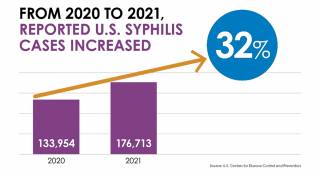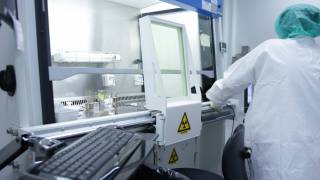HIV Vaccine Production 2.0

Research on HIV over the past decade has led to many promising vaccine production ideas, but very few vaccine candidates have been tested in clinical trials.
One reason for this is the technical difficulty of manufacturing vaccines based on the envelope proteins of the virus.
According to Phil Berman, the Baskin Professor of Biomolecular Engineering at UC Santa Cruz, his team’s new production approach deploying robotics solves previous technical problems.
This new robotic process shortened the time required to produce stable cell lines from 18 to 24 months to just 2 or 3 months while increasing yields by a factor of 100 to 200.
"Dozens of interesting vaccine candidates have been described, but most have not been tested in humans because it has not previously been possible to manufacture them affordably and in a timely fashion," Berman said.
"The technology we developed should break the logjam in HIV vaccine development, because it tremendously shortens the time, improves the yield, and lowers the cost."
These researchers are using robotics to shorten the time required to produce stable cell lines, needed to make the proteins for a vaccine, while at the same time greatly increasing how much of the protein the cell lines can produce.
This production process improvement makes it possible to reduce the size of the bioreactor needed to make the vaccine for large clinical trials--from 2000- to 10,000-liter vessels to 50- or 100-liter vessels--resulting in tremendous savings in the equipment required and cost of materials.
In addition, Berman's lab was able to create cell lines that make HIV envelope proteins with the right kind of carbohydrate components (called glycans) needed for an effective immune response.
"The carbohydrates attached to the protein are really important, something no one realized until recently," Berman said.
"The conventional way of making these envelope protein vaccines incorporated the wrong kind of carbohydrates. We now know what destroyed many of the important antigenic sites recognized by protective antibodies."
Cell lines derived from Chinese hamster ovary (CHO) cells are the industry standard used to produce complex recombinant proteins for therapeutic use. These cells are also useful for the production of HIV vaccines.
The gene for the desired protein is transferred into CHO cells in a process called transfection, and tens of thousands of transfected cells are screened to find the few rare cells that produce large amounts of the protein.
The best cell lines are grown in large batches, in a process similar to yeast fermentation for making beer, and the proteins are then isolated and purified.
"People used to think carbohydrates are not immunogenic, but HIV turns everything on its head, and it turns out that the most important antibodies are directed to this unusual carbohydrate," Berman said.
"We can now make vaccines with it for the first time, and we've created an improved version of the vaccine used in the RV144 trial.
RV144 remains the only HIV-1 vaccine trial to demonstrate efficacy against HIV-1 acquisition.
“Our hope is that it will bring the efficacy up from 31 percent to greater than 50 percent, the level likely required for product registration," said Berman.
This research was funded by major grants from the National Institute of Allergy and Infectious Diseases at the National Institutes of Health. Berman did not disclose any conflicts of interest.
Our Trust Standards: Medical Advisory Committee

























